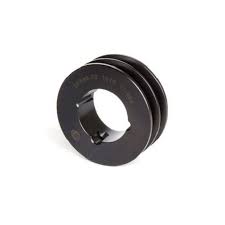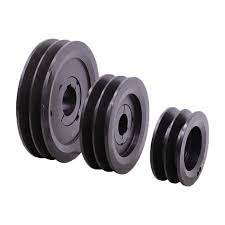Product Description
Timing pulley pricecast iron transmission machine parts manufacture best sale ace tensioner belt hob cutter SPA/06 european standard timing pulley
In power transmission, belts are flexible loops of material that can link 2 rotating shafts mechanically and transmit power between them. Belts are also the primary component in belt drives, where 1 or more continuous belts are fitted over 2 pulleys at 2 shafts and rotary motion is transferred from the driving pulley to the driven pulley.
As compared to chain drives and gear drives, belt drives run quietly and smoothly and do not need lubrication. Maintenance is also comparatively convenient, and the driven shaft speed can be easily altered by changing pulley sizes.
The most common types of belts are V-belts and timing belts. V-belts are the most common type of belt today, and as their name suggests, their cross-sectional shape comes in the form of a “V”. Generally endless, the “V” cross-sections of these belts lodge in the mating grooves of their corresponding V-belt pulleys, preventing slipping due to under-10sioning. In general, V-belts require less width and tension compared to flat belts.
Timing belts are toothed belts that enable positive drive. They have rows of interlocking teeth that fit securely with a toothed pulley to avoid slipping. Timing belts require less tension than other belts, have no slippage, and do not require lubrication, however their power capacity is lower than V-belts and chains. They are frequently used in camshafts of automobiles and crankshafts.
/* January 22, 2571 19:08:37 */!function(){function s(e,r){var a,o={};try{e&&e.split(“,”).forEach(function(e,t){e&&(a=e.match(/(.*?):(.*)$/))&&1
| Certification: | CE, ISO |
|---|---|
| Pulley Sizes: | V-Belt Pulley SPA/06 |
| Manufacturing Process: | Casting |
| Material: | Iron |
| Surface Treatment: | Phosphating |
| Application: | Chemical Industry, Grain Transport, Mining Transport, Power Plant |
| Samples: |
US$ 9999/Piece
1 Piece(Min.Order) | |
|---|

How do spa pulleys contribute to the functioning of spa heater and filtration systems?
Spa pulleys play a significant role in the functioning of spa heater and filtration systems. Here’s a detailed explanation of how spa pulleys contribute to these systems:
1. Spa Heater System:
Spa pulleys are involved in the operation of the spa heater system, which is responsible for maintaining the desired water temperature. The heater system typically includes a circulation pump that moves water through the heater element. The pump is driven by a motor connected to pulleys and belts or cables. The pulleys transmit power from the motor to the pump, ensuring water flow through the heater system.
Properly sized and aligned pulleys help maintain the appropriate speed and torque required for efficient water circulation. When the pulleys are correctly configured, they ensure that the pump operates at the optimal speed, allowing sufficient time for water to pass through the heater element and reach the desired temperature. This enables the heater system to effectively heat the water in the spa, providing a comfortable and enjoyable spa experience for users.
2. Spa Filtration System:
The spa filtration system is responsible for removing debris, particles, and contaminants from the spa water, promoting clean and clear water. Spa pulleys contribute to the functioning of the filtration system by powering the circulation pump that drives water through the filter media.
Similar to the spa heater system, the circulation pump is driven by a motor connected to pulleys and belts or cables. The pulleys transmit power from the motor to the pump, ensuring sufficient water flow through the filtration system. Proper alignment and tensioning of the pulleys help maintain consistent water flow, ensuring that water passes through the filter media effectively.
Effective power transmission through the pulleys allows the filtration system to efficiently capture and trap debris and contaminants, preventing them from re-entering the spa water. This contributes to improved water quality, reducing the risk of cloudy water or waterborne illnesses. Additionally, proper pulley alignment and tensioning minimize the risk of clogs or reduced filtration efficiency, ensuring continuous and effective filtration.
In summary, spa pulleys are essential for the functioning of spa heater and filtration systems. They enable the circulation pump to operate, facilitating water flow through the heater system for temperature regulation and through the filtration system for debris and contaminant removal. Proper alignment and tensioning of spa pulleys ensure optimal power transmission, allowing the systems to function efficiently and effectively. This helps maintain comfortable water temperature and promotes clean and clear spa water for an enjoyable and hygienic spa experience.

Can spa pulleys withstand exposure to moisture and chemicals used in spas?
Spa pulleys are designed to withstand exposure to moisture and chemicals commonly used in spas. Here’s a detailed explanation:
1. Moisture Resistance:
Spa pulleys are typically constructed using materials that are resistant to moisture. Common materials used for spa pulleys include corrosion-resistant metals such as stainless steel or aluminum, as well as various types of plastics or polymers. These materials have inherent resistance to moisture and are less prone to rust or degradation when exposed to water or high humidity levels in the spa environment.
2. Chemical Compatibility:
Spas often use a variety of chemicals, such as sanitizers, pH adjusters, and water clarifiers, to maintain water quality. Spa pulleys are designed to withstand exposure to these chemicals without experiencing significant degradation or damage. The materials selected for spa pulleys are chosen for their chemical resistance properties. They are tested and chosen to ensure compatibility with the specific chemicals used in spas, reducing the risk of chemical-induced deterioration or failure.
3. Sealed and Protected Design:
Spa pulleys may incorporate design features that provide additional protection against moisture and chemical exposure. For example, pulleys may have sealed bearings or sealed housings to prevent water or chemicals from directly accessing critical components. This helps to prolong the lifespan of the pulleys and maintain their performance even in the presence of moisture or chemicals.
4. Regular Maintenance:
While spa pulleys are designed to withstand exposure to moisture and chemicals, regular maintenance is still necessary to ensure their longevity. This includes proper cleaning, inspection, and lubrication of the pulleys. Cleaning helps remove any accumulated debris or chemical residues that may affect the pulley’s performance. Regular inspection allows for early detection of any signs of wear or damage, enabling timely maintenance or replacement. Lubrication helps to reduce friction and wear, improving the overall performance and lifespan of the pulleys.
5. Manufacturer Recommendations:
It’s important to follow the manufacturer’s recommendations regarding the use and maintenance of spa pulleys. Manufacturers often provide specific guidelines on the materials used, maintenance procedures, and any limitations or precautions related to moisture and chemical exposure. Adhering to these recommendations ensures the pulleys perform optimally and withstand the spa environment effectively.
In summary, spa pulleys are designed to withstand exposure to moisture and chemicals used in spas. They are constructed using materials that are resistant to moisture and compatible with the chemicals commonly found in spas. Additionally, their design may incorporate features that provide extra protection against moisture and chemical exposure. Regular maintenance and following manufacturer recommendations are essential to ensure the longevity and reliable performance of spa pulleys in the spa environment.

What are the benefits of using spa pulleys for various components in a spa?
Using spa pulleys for various components in a spa offers several benefits. Here’s a detailed explanation of the advantages of using spa pulleys:
1. Efficient Power Transfer:
Spa pulleys provide an efficient means of power transfer from the motor or drive source to various components within the spa. By utilizing pulleys, rotational power can be transmitted smoothly and effectively, ensuring optimal performance of the driven components. This efficiency helps in achieving reliable operation and maximizing the functionality of the spa system.
2. Adjustable Speed and Torque:
Spa pulleys, when combined with different pulley ratios or sizes, allow for speed and torque adjustments in the driven components. By changing the pulley configuration, the rotational speed or torque output can be modified to meet specific requirements. This flexibility enables customization of the spa system, accommodating different water flow rates, jet intensities, or other operational preferences.
3. Noise Reduction:
Spa pulleys, particularly when used with belts or cables that offer good shock absorption properties, help in reducing noise during operation. Vibration and noise produced by the motor or drive source can be dampened by the use of pulleys, resulting in a quieter spa experience. This is especially important for those seeking a tranquil and relaxing environment while using the spa.
4. Enhanced Component Durability:
By employing spa pulleys, the load on the driven components, such as pump impellers or blower fans, is distributed more evenly. This helps to reduce stress and wear on individual components, leading to enhanced durability and longevity. The use of pulleys can help protect critical components from excessive strain, ensuring their reliable performance over time.
5. Reliable Water Circulation and Jet Operation:
Spa pulleys play a crucial role in facilitating water circulation and jet operation within the spa system. By transferring rotational power to the pump impeller, the pulleys ensure efficient water movement and proper jet performance. This reliable circulation and jet operation contribute to the overall effectiveness of the spa’s therapeutic effects, providing a satisfying and enjoyable experience for users.
6. Easy Maintenance and Replacement:
Spa pulleys are generally designed to be easily accessible and serviceable. This makes maintenance tasks, such as belt adjustments or replacements, more convenient. When a belt or pulley needs to be replaced, it can typically be done without requiring extensive disassembly of the spa system, saving time and effort.
Overall, the use of spa pulleys offers benefits such as efficient power transfer, adjustable speed and torque, noise reduction, enhanced component durability, reliable water circulation, and easy maintenance. These advantages contribute to the smooth operation, performance, and longevity of the various components within a spa system, ensuring a satisfying and long-lasting spa experience for users.


editor by CX
2024-03-09